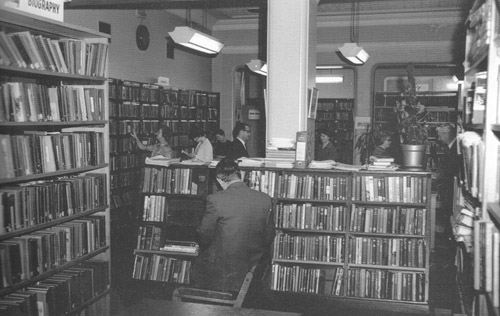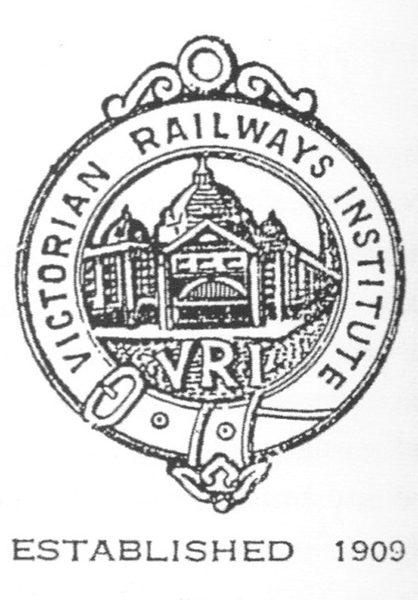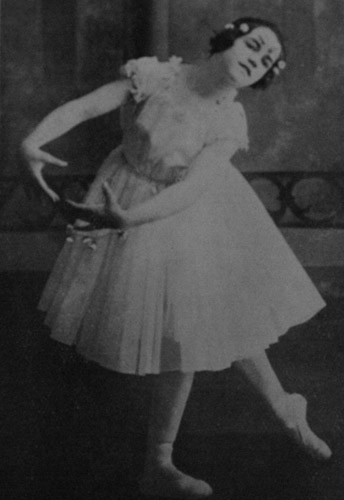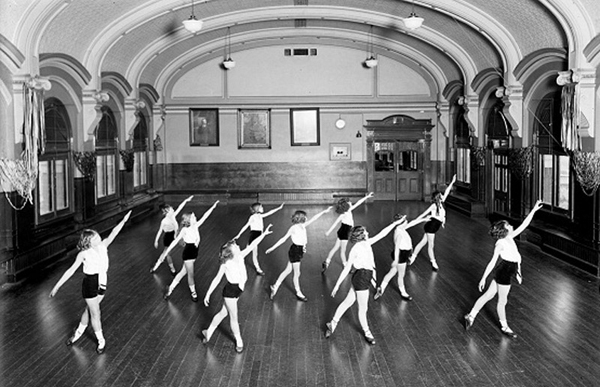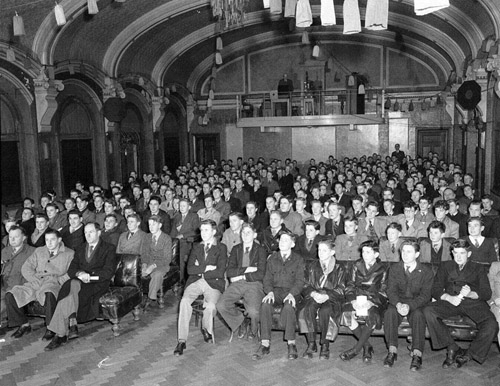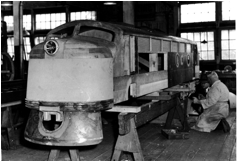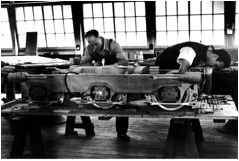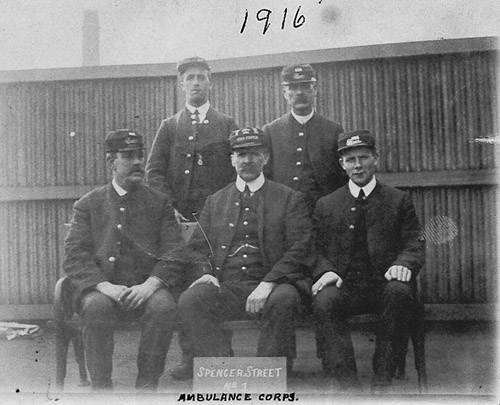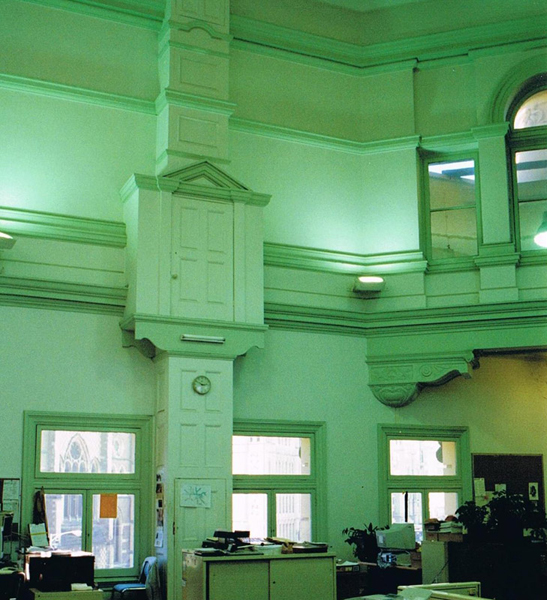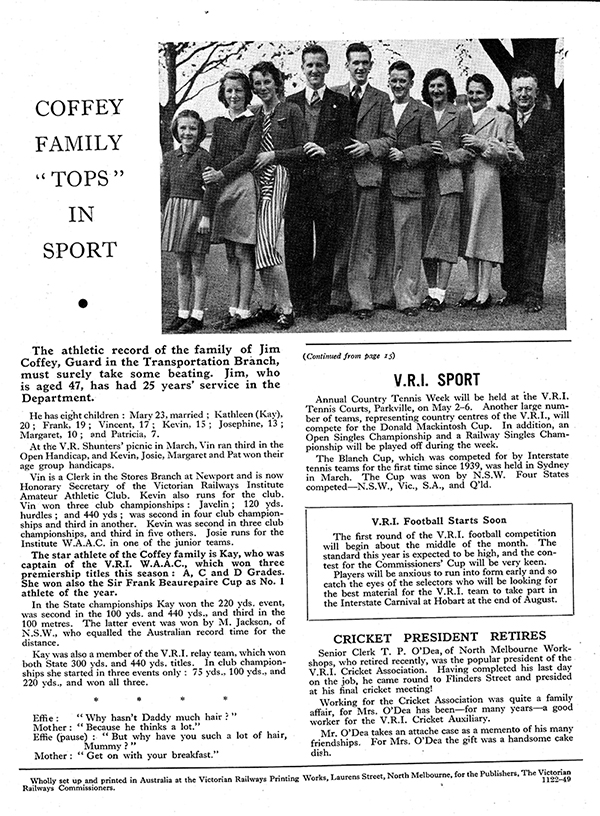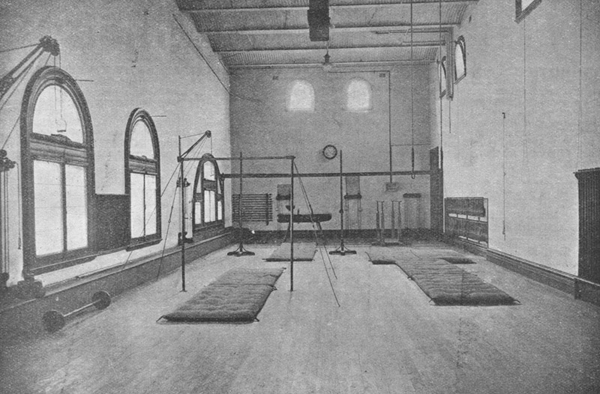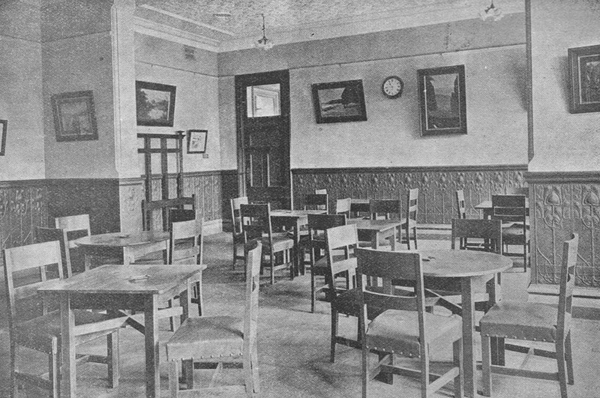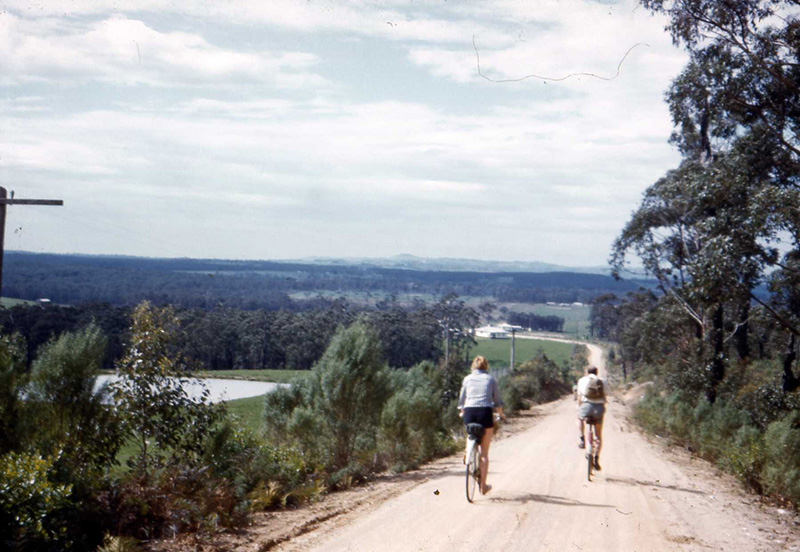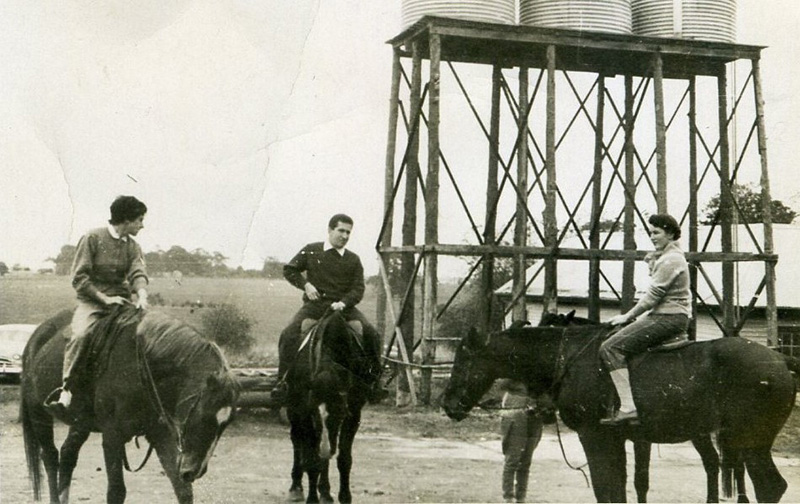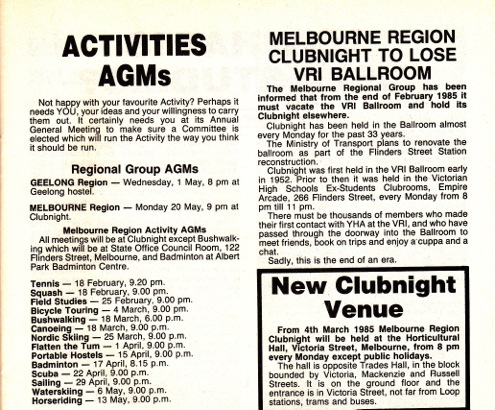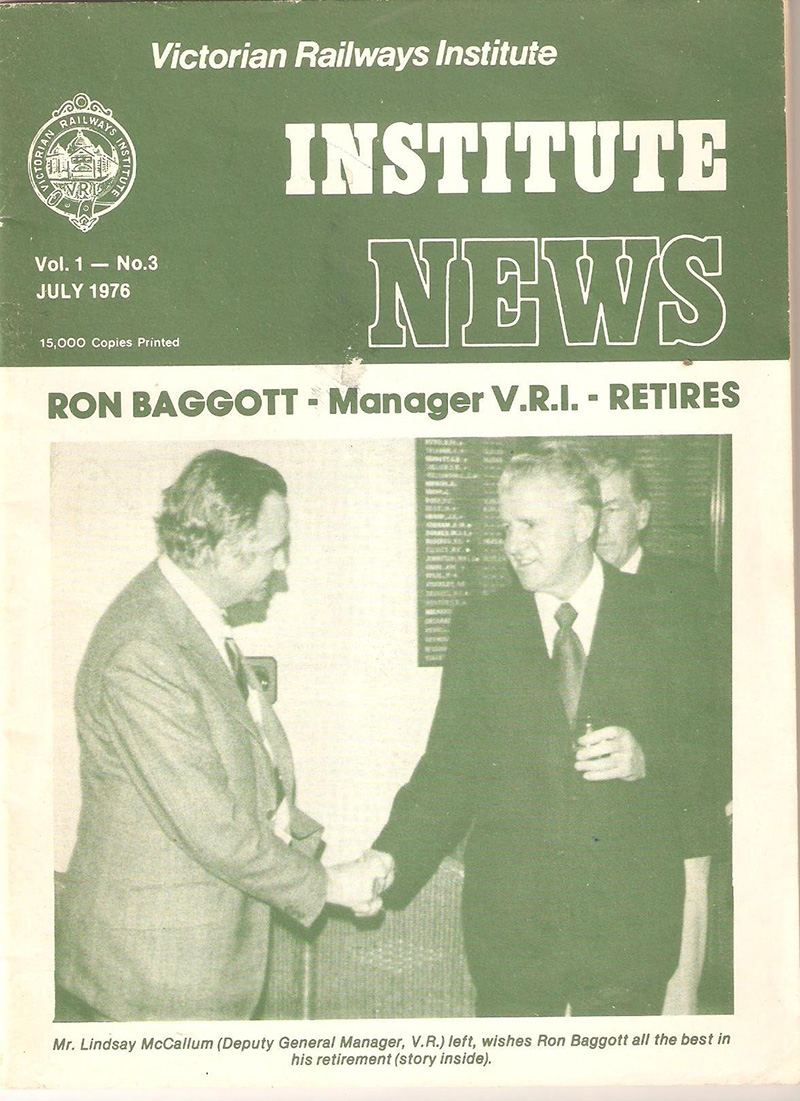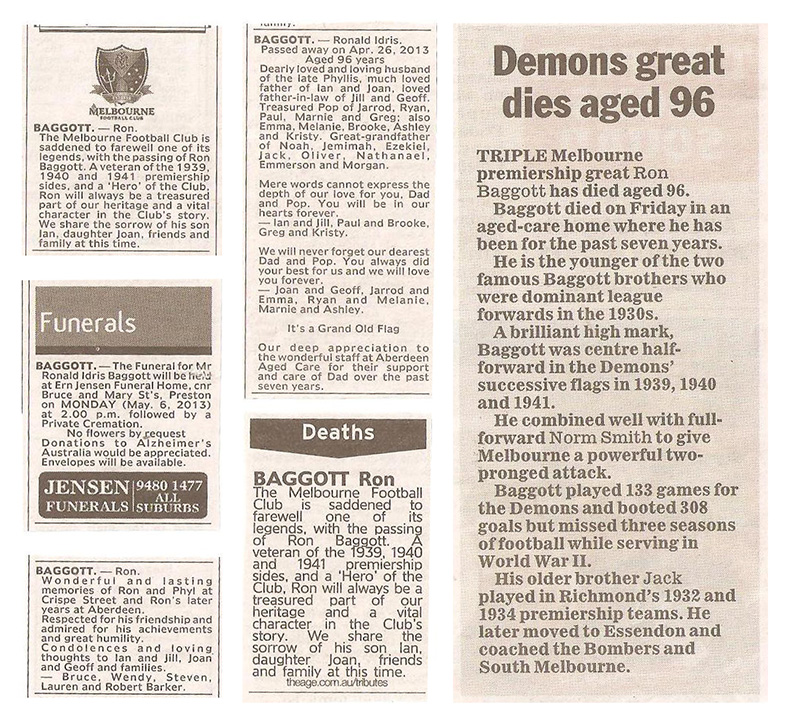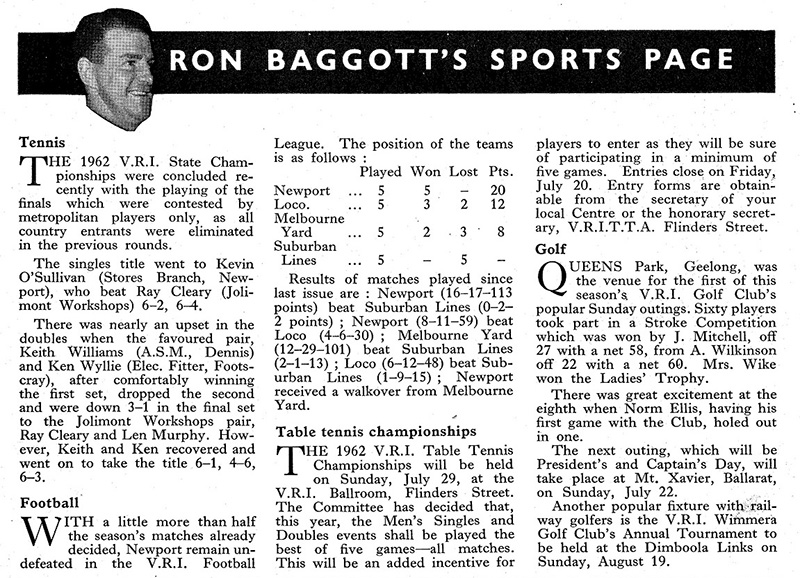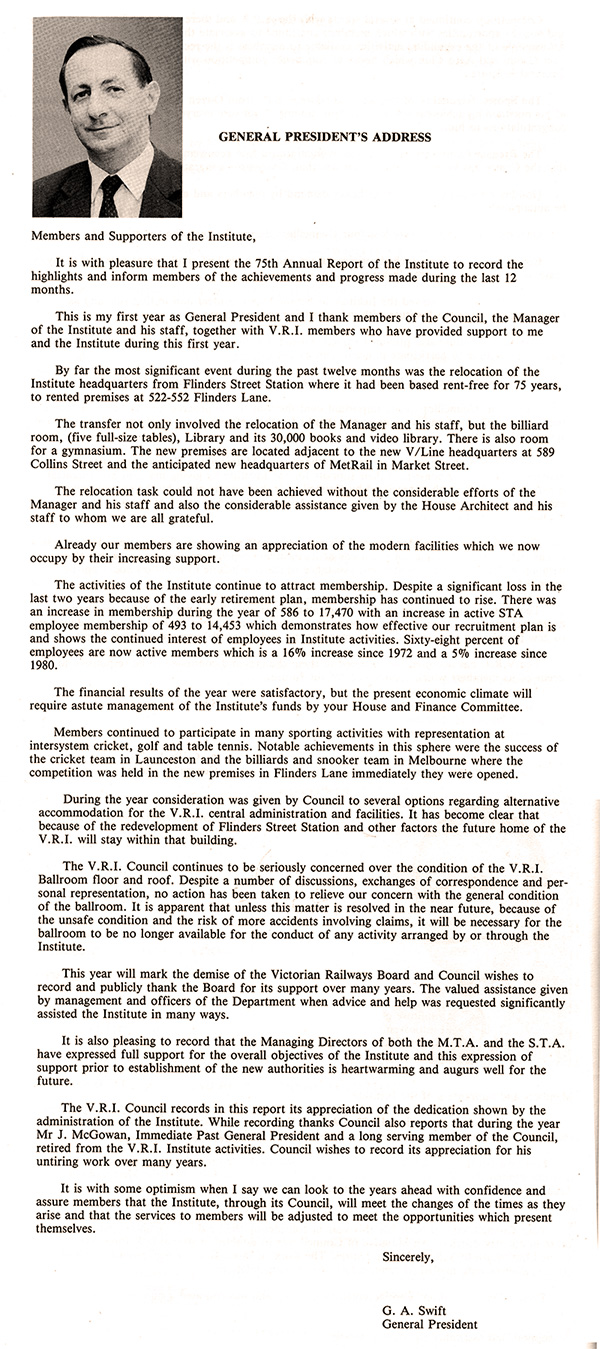THIRD FLOOR: STORIES
inside flinders street station: The Gymnasium
Click here to watch The Age Flinders Street Series: The Gymnasium (Source: The Age)
inside flinders street station: The BALLROOM
Click here to watch The Age Flinders Street Series: The Ballroom (Source: The Age)
Library Romance
VRI Library in 1961
|
I listened to Jenny’s station stories with great interest though I couldn’t think of anyone I could buy a book for and I was well past accumulating more. The following Saturday night was my brother’s Golden Wedding Anniversary. His second sentence started off with, “I met my wife at the VRI Library.” Well, none of us had heard that before! He proceeded to tell us that he had seen this gorgeous young thing – he being 16 and her being 15, one day when he was returning his books. It seemed that she had noticed him as well because the coincidence of being at the library at the same time kept increasing. They’d pass each other in the corridor and smile and nod. Their friendship developed and well, now they were celebrating 50 years of marriage. I had to buy them a book. |
Generations of Donald Fidges
VRI Library in 1961
|
Mr Don R Fidge wrote to me from Queensland in June 2009 just after my book was launched. His father, then about to turn 80, was very excited when he read about the book in The Australian. Don wrote the following story: “My grandfather, Donald Francis Fidge, was a young man employed by the Victorian Railways when he died suddenly in October 1947. (He was watching the 1947 Caulfield Cup being run when he collapsed and died in front of my father who was only a schoolboy at the time.) In late 1947 my father, Donald Keith Fidge, went to the Victorian Railways Institute library to return his father’s library card but when he explained the situation he was told that he could keep and use the card and any other facilities in that big yellow building in Flinders Street. My father used that library card for many, many years and I myself (Donald Robert Fidge) used that card in the 1960s. I was a young child at the time but no-one ever queried how I was a member of the Victorian Railways Institute. My father was an accountant (he never worked for the railways although his father and his step-father did) and he studied for his accountancy exams in that same building in Flinders Street. My parents attended dances in the ballroom and my father used the running track while training as an amateur Aussie Rules footballer. Just by coincidence, the coach/manager of my father’s football team in Essendon was the drummer for the regular band at the VRI Ballroom.” |
Saving the Payroll
VRI Logo
|
I’d only been employed for three weeks as a junior clerk at Head Office when this incident occurred. It was February 17, 1972 and I was only 17. The Payroll was made up at Spencer Street and I had to deliver it to the Pay Office at Flinders Street Station on the 2nd floor for them to make up the cash packets. The last thing my boss said to me was, “Guard this with your life!” It was the day of the torrential downpour in Melbourne and as I approached the corner of Elizabeth and Flinders Street I was caught up in the rush of storm water that barrelled down Elizabeth Street, sweeping me up in any eddy. I desperately tried to keep the large payroll package dry above my head as I swirled down toward the station. I managed to scramble up on to Platform 1 still clutching the payroll for dear life. I couldn’t get to the main entrance so I struggled up the fire escape on the south facade, banging on the windows at each level for someone to let me in. Finally I was heard and climbed through the window and down to the office. I was soaked and so was my precious parcel. We undid the string and managed to separate the pages. Luckily there was no much smudging so we strung them up across the office to dry. This took several days but all turned out okay. I was very afraid to face my boss but when I did, he said something like, “I’m so glad you’re okay!” It was a memorable start to several years of working with the VR. |
Miss Dorothy Gladstone
Miss Dorothy in Graceful Pose - 1924
|
This photo of Dorothy Gladstone appeared in the VRI Review August 1925 with the caption: In Graceful Pose in the Victorian Railways Institute dancing class. This photo accompanied an advertisement for her classes which were arranged through the VRI. The first evidence of Dorothy teaching classes with the VRI was in 1921. She had a ‘permanent booking for Room 56 on the 2nd floor’ for sixty years. Many of her students and student teachers remember having dance classes in this room and sometimes in Room 52 as well as in the ballroom. Both these rooms were also used for VRI educational classes. The VRI AGM (1948) included the following report on Dancing (Miss Dorothy Gladstone). The VRI AGM (1961) recorded that:
|
Physical Culture in the Ballroom
Physical Culture in the early 1930s
|
This photo was probably taken soon after the formation of the ladies physical culture class in 1931. The VRI Minutes (19 Feb 1931) state that: LADIES’ PHYSICAL CULTURE CLASS After consideration it was decided to RECOMMEND that a class of instruction for ladies, embracing physical culture, eurhythmics and folk dancing, be organised and conducted in the Gymnasium on Wednesday evenings commencing 8th April and that the fees be as follows: BALL-ROOM DANCING CLASS DECIDED that Miss Gladstone be given the use of the hall to conduct this class at a fee of 2/- per lesson, she to pay £1.1.0.per evening for the use of the hall, commencing from 5th May. This Committee has accepted responsibility for supervising Miss Gladstone’s teaching work owing to the fact that Miss Gladstone will be using the Gymnasium on one night per week, but it does not wish to accept responsibility of conducting or supervising social evenings or dances.
|
Dance Bands of the 1930s and 40s
This is a photo of my dad’s first band dated 1929/30. Dad was on banjo
|
Reading about the station brought back memories of my childhood in the late 1930s and early 40s when my father ran a dance band and played regularly at the Ballroom. He used to take me along for the night, especially for the “Old Tasmanians” held especially for railway workers from Tasmania. A very popular hop it was and the dance floor was packed. Snowy Klemm (my dad) was the sax player and , with Cec Evans the piano player, recruited drummer Alec Dunlop and trumpet player Mick McKim for their small band at the VRI engagements and for engagements around the Yarraville and Footscray area. We lived in Footscray as did most of the bandsmen and there were many others that could be recruited for a hastily arranged function. I was sent around with a note to various addresses until there were enough players for the band. When a larger orchestra was needed for balls, they could add Stan Walker with another sax, Joe Vosti on double bass and his son Brian on vibes. Players were always dressed with polished shoes with no laces showing, dinner jackets and black bow ties. A few other kids and I that turned up were shoved off further down the corridor to the railways gym where we watched the athletes working out. There was boxing, wrestling and the “in” sport at the time – marathon skipping. The famous unionist, JJ Brown, went on to break the world record there. Famous footballers like Jack Dyer exercised in that gym and when finished and dressed, would venture down to join in the dances. It all had to finish before midnight so that everyone could scurry down the stairs to catch the last trains home. PS I’m not sure if I should be mentioning it about those attending the dances at the ballroom but those arriving by train could make their way to Platform 1 and gain access to the outside stairway (which was actually the fire escape) and enter the top floor without having to have a train ticket to surrender at the barrier. Note from J Davies: A retired VR Apprentice told me that the mixture used to create such wonderfully slippery dance floors was a combination of sawdust with a little bit of turps mixed with shaved candles. This mixture was used on all the dance floor of the VRI Halls throughout the state. |
YHA at the Station
Physical Culture in the early 1930s
|
Did you know that the Youth Hostels Association ran the best matrimonial agency in Melbourne at the end of the 1950s from the VRI Ballroom? I have lived in, or near Melbourne, for most of the last 78 years and I have many memories of the station. In the 1950s the YHA had a large number of associated social clubs and they all used to meet in the VRI Ballroom every Monday evening. The various clubs would set up tables to organise their social activities. At the end of the evening many of the members would have coffee in one of the nearby coffee shops, providing an excellent opportunity to meet other young people with similar interests. From 1951 to 1954 I studied engineering at Melbourne University and joined the Mountaineering Club – MUMC. I meet several people who were also members of the YHA walking club and they suggested I should also join. The office told me that before I could join I had to attend several orientation lectures. My attendance at one was more than enough! My friends said not to worry about that but just come along on Mondays anyway. I never did join the YHA but I did go on a number of their walks and even lead one. In 1960 a few girls from the YHA bought a Land Rover and one of them asked if I would be their ‘mechanic’ on a trip to George Gill Range and Kings Canyon. The girl had an English friend with her whom she had met through the YHA badminton club...I looked at the English girl and answered, “Yes.” When we returned to civilization the girls commented that they hadn’t really needed me as nothing had gone wrong...but I did marry the English girl and we had three children. Many of our YHA friends also married people they had met through the club and most of these marriages were successful...I have fond memories of the YHA and the VRI Ballroom. |
The Melbourne Bushwalkers: My story from 1948 to the 1960’s
|
In March 1947 when the first ‘Refugee ship’ arrived in Australia, I was a teenager and was most excited to settle in Melbourne with my uncle & family, who had sent me the permit. Australia did not want us: we were a shabby looking lot with 720 mostly older people coming to families with 30 teenagers and I think 4-5 babies. I still remember I was most welcomed by the president, Egon Donath and Victor Jacoby, pre-war refugees from Germany – Austria. Egon started the Bushwalkers in1940 with the help of one of Melbourne University’s professors saying, ‘European young people are used to spending the week in fresh air, climbing mountains. So with a little help from the Government he and others became active bushwalkers. Some of the first Australians I became friends with were: Frank Pitt, Fay Pitt, Marie Gillespie and many others. During the Second World War (the Holocaust) having lost all my family, I was lucky to have my mother’s brother & his wife in Melbourne. They sent me one of the post war permits. Joining the Melbourne Bushwalkers gave me a new beginning - not just many new friends, but getting to know the Dandenongs and many other places in Australia. Egon Donath and Victor Jacoby (who were much older than me) became my mentors and also introduced me to the brand new Council of Adult Education (just changed from Workers’ Education) led by Colin Badger and Noel Anderson. One of my first lecturers was Zelman Cowan (later, Sir). I was made a settled Australian. I have some old photos. I went to GOOGLE to look up some dates and the entry stated Egon Donath as the first president. When I got to page 20 I found myself on the right of one photo on a hike in 1950, taken by Hans Eisfelder, my boyfriend for a short time. I have just turned an active 85 year old. I still love Melbourne. In my single days I occupied a little ‘Studio flat’ in Prahran and had many parties for my bushwalker friends. |
The Apprentices of 1951
Encouraging Apprentices - the 1951 intake |
I discovered that this photo was incorrectly labelled as 1948 when I had the privilege of meeting the 1951 Apprentice group at a function in the North Melbourne Bowling Club in 2011. When I showed the group this photo, one of the organisers, Barrie Milburn exclaimed, “Ah, that’s me in the front row, 3rd from the right sitting next to John.” John was also at the function and they told me that they had been inseparable since childhood having lived next door to each other, attending the same schools and joining the Victorian Railways as apprentices in 1951. Barrie commented that he was wearing a suit that his mother had made. At age 17 he was ready for a long career with the railways. Barrie and John both did their apprenticeships as fitters and turners. Ray Strong who had organised the event also trained as a fitter and turner then went on to become a tool maker.
Apprentices were traditionally welcomed at an event in the Ballroom. The Chief Commissioner, Robert Wishart, at Cliff’s introduction in the mid 1940s stated: You young men are the cream of Victoria’s youth and we expect that through diligence and application that you can rise to where I am today. |
Malcolm’s Story
|
Malcolm Durant was a VR Apprentice from the 1951 intake. He was a keen sportsman, being both a runner and a football player. He won the Stawell Gift in 1958 and in 1963, won both the 600 yards and the 880 yards (1/2 mile) events. Malcolm was also part of the 1958 Newport Premiership Team. When he became a professional runner he stopped playing football. In 2011 Malcolm sent me some photos of the patternmakers who built the B60 diesel loco at the Newport Workshop that was to be named ‘The Harold Clapp’. Malcolm was a 3rd year patternmaker apprentice in 1954 and along with patternmakers Max Small, Merv Williams and Anderson, constructed the model out of timber under the direction of Foreman Pattern-maker, Davey Yates.
The B60 Model – 1/3 scaleThe carriage painters sprayed the body VR blue and Cliff Clark and Brian Sullivan, experienced painters, created a stencil for the VR wings and painted them gold. This was a specialist job and Cliff says his initials are underneath the model. The Coat of Arms was painted by George Morris who was a ‘classified’ Rolling Stock sign writer. He was also a household name in the 50s, not for his sign writing but for his quiz expertise, both on radio and with Bob and Dolly Dyer on the fledgling TV quiz shows. Unfortunately George did not have a TV persona and was replaced by Barry Jones. Anyway, George was the skilled sign writer of the Rolling Stock and also worked on the advertising rail wagons, head boards for special occasion engines and logos etc. |
Ambulance Man Doyle
The photo is of my grandfather with four other chaps and labelled “Spencer Street No.1 Ambulance Corps”, 1916.
|
In 1907 at the age of sixteen, young James Doyle followed his father into the Victorian Railways. This was his first great love as he worked with the railways for 49 years He was a regular passenger to and from Melbourne and Geelong. My grandfather’s second great love was his volunteer work as a St. John’s Ambulance man. St. John’s Ambulance has been active in Australia since 1883. The Victorian Railways established a volunteer ambulance corps in 1884. By the early 1900s it was mandatory for members of the Transportation, Rolling Stock and Ways & Works Branches to have a first aid certificate. Different levels of first aid were required depending on the requirements of the particular occupation. Ambulance competitions proved an excellent way for different branches of the railways, and different districts to demonstrate and further their skills. After the opening of the new station in 1910, the Victorian Railways Institute was notified by the Victorian Railways in March that ambulance classes were to be conducted in its rooms. In 1911, an article in the VRI Review states:- Jim’s diary states: “Went for First Aid Examination 23rd August 1911 also on 26th August”. His diary also mentionsthat “An Ambulance Demonstration was held at the Railways Institute, on Thursday 29th August 1912”. The following year another course was conducted and a certificate dated 24thJuly 1913 was issued stating that, “that James Doyle who obtained an Elementary Certificate of ability to render ‘First Aid to the Injured’ has attended a further course of instruction at the Flinders Street Railway Sub-Centre and has been successful in passing the examination with ‘Credit’. His diary mentions hegot a note re joining the crack No. 1 Spencer Street Railway Ambulance Corps on 2ndMay 1912, (his) 1s t night was 7thMay 1912”. By 1911 at the age of 20, Jim was introduced to his third long-standing love - the Geelong Football Club. At the old East Melbourne ground in June 1911, a Geelong player, Rupert Brownless, met with an accident. Jim treated the injured player and as a consequence was appointed ambulance officer to the club. He took over from Charles Brownlow of The Brownlow Medal fame, who was then Secretary of the Club and the attendant for injured players. Jim was duly and formally appointed each year by Brownlow until his sudden demise in January 1924. Such was his dedication to the position of Club’s Honorary Ambulance Officer that in 36 years, grandfather missed only 7 games and had travelled 30,000 miles by train, to and from Geelong on Saturdays. He was quoted as saying, “Football and especially the Geelong brand, is really a part of my life now.” He was still their ambulance man in 1970. A note in grandfather’s diary states, “A football match played between Spencer Street Porters and Cabmen Football Club on 5th August 1910. A win for Porters resulted seven goals four behinds forty-six points to Cabmen four goals two behinds twenty-six points”. As a labourer with the railways, Jim retired with a personal copy of the Victorian Railways 1907 Rules & Regulations - a 430 page book. On retirement in January 1956 he had accumulated 62.4 weeks long service leave and 55 days annual leave. |
Visiting Dad in the Dome Room
3rd floor room under the Dome
|
My recollections are drawn from my experiences as a son of a railwayman who worked in the building, as a traveller and as railway enthusiast/historian. As a boy, I and my siblings would visit my father at his workplace which was in the room on the third floor directly under the dome facing the intersection of Swanston and Flinders Streets. Dad was an engineer in the design section of the Victorian Railways Electrical Branch which had moved to this part of the Flinders Street Station building in the early 1930s from the State Savings Bank building at the corner of Collins and Spencer Streets. Because of the tightness of money during the Great Depression, the railway commissioners ordered that railway functions had to be housed in Departmental-owned buildings (where possible) to avoid paying rent. One of the advantages of Dad working in the room under the dome was that it gave the families of the Electrical Branch staff an ideal place from which to watch the procession of the arrival of the Duke of Gloucester at the start of the Victorian and Melbourne centenary celebrations in 1934. I was aged 12 at the time. |
The Coffey Railway Family
Coffey Family VR Newsletter May 1949
|
James Francis Coffey joined the Victorian Railways on 10 December 1924. He had wanted to join the army but on applying, he encountered his father’s best friend. Having run away from boarding school in SA after the war, he was unlikely to be accepted! Born 6 June 1901, the then 23 year old joined the VR as a shunter. In 1929 his pay is stated as 14s. 9d. Josie, born in Brunswick in 1935 and one of 5 daughters, remembers her mother grilling her dad about Safe Working Rules & Regs to prepare him for a promotion to Guard which was the position he remained in for his working life. Her dad never wore a belt to work following a nasty incident as a shunter when it got caught on the edge of a moving carriage. He just managed to turn his lamp around to ‘red’ and the driver, luckily saw it and stopped. As a VRI family, all 8 children and the wife were entitled to borrow books from the library on the 3rd Floor. Josie as a 10 year old remembers how ‘helpful the ladies were’ and how she and her sisters would catch the Brunswick train to the library. This was where she first encountered the exciting National Geographic. Younger sister, Pat, recalls how they used to stare into the fantastic billiard room full of men only, making sure that the tips of their shoes did not cross the threshold! Josie, at age 14 and about to leave school, applied for a scholarship but did not win one so at age 15, joined the railways. The new ‘Mercedes’ accounting machines had just been purchased and there was a need for girls to be trained to use them. Josie attended Typing and Shorthand classes at the VRI and worked in the Accountancy Branch. They drew the cheques for the Commissioners who were the only VR employees to be paid this way – the others were all paid in cash. Josie remembers drawing the cheque for ‘Heavy Harry’ as this was a very significant claim and happened on Christmas Eve. Miss L Neville was the VRI secretary for many years and her office was just to the right on the third floor beside the lift. This was where you paid your fees for various classes and memberships. She was a force to be reckoned with. Most of Josie’s family were involved in athletics at some time and she, at age 13 was able to join the Women’s Athletic Club along with her older sister Kay, born in Warrugal in 1928. Kay became the club captain as was the number 1 athlete. Her trainer was Mr Williams from the Head Office. Josie’s favourite events were shot put and discus, not keen at all to participate in hurdles or high jump. The number and type of events that women could participate in during any competition was limited with the 400m being the longest track event. The VRI had the only women’s athletic facilities in Melbourne, situated at Royal Park. Athletics training was on Monday and Wednesday nights with practice in the local park on Sundays. Competitions were held in summer. According to the Melbourne City Council Regulations, men needed to gain written permission to set foot on those grounds. The men’s facility at that time was at Olympic Park. Both Josie and Pat have fond memories of the Shunters’ Picnics which were held annually at Eltham until the armed services took over the land during the war, then at Carrum. That picnic site was quite a long way from the train station, the sisters recall. The picnics included all kinds of events and their mother participated in the married ladies’ races and there were lots of events for the boys and girls. The various VRI Sporting Clubs were on a roster to help out at the VRI dances held in the ballroom on Wednesday nights. The Women’s Athlete Club took their turn at the cloakroom and selling Tarax drinks served from bottles poured into glasses in the kitchen at the west end. There was never any alcohol. The profits made went to the club on duty. Both Josie and Pat have many other fond memories of the VRI and the athletics club. When the club folded in 1982, Josie was a founding member of the Brunswick Athletic Club which Pat was able to join as she had just turned 13. |
A Railway Family’s connection to the VRI
A Railway Family’s connection to the VRI
|
My dad, Donald Keith Fidge, went to primary school in Buckrabanyule. His dad was the stationmaster there during the 30s. At 11am the passenger service from Sea Lake to Bendigo if it happened to be on time and at 3pm the Bendigo to Sea Lake service was due. The only other trains through Buckrabanyule were goods trains loaded with wheat – maybe as many as 10 per day but only for 3 months of the year. Goods trains loaded with wheat are very attractive to mice and during mice plagues, the number of mice squashed on the tracks were sufficient to halt train services. Dad managed to win one of 20 tech school scholarships so the family relocated to Glenroy. He was able to use the VRI Gym on Saturday mornings. This was about 7 decades ago but he still complains about being bullied by larger and older gym patrons – he was the ‘skinny kid from the bush’. Despite this, he used the gym for 3 or 4 years. Many years later, in about the 60s, he worked in an office in Melbourne with 2 big blokes who used the gym and wrestling ring during their lunch break. Neither had any connection to the VRI or any permission to be there but the gym was rundown and derelict by this time and no one stopped them from just walking in. Dad trained in the gymnasium while he was playing football for his school and an amateur team in the Footscray Districts League originally, before it transferred to the Essendon League and became known as the Essendon All-Blacks. He said he didn’t use the running track on the roof, although he knew it was there, because he didn’t know how to get up there. The Manger of the Essendon All-Blacks was Hood Thomas who had a strong connection to the VRI and its ballroom. As well as being the club manager, Hood Thomas was the drummer and the leader of the resident band that played at the dances each Friday and Saturday night in the ballroom. From about age 18 to 22, dad used to go to the dance on a Friday night with my mother. Dad’s attendance on the night before the football games was a sore point with Hood Thomas as he thought that dad should have attended the dances organised by the footy club which did not interfere with training or the games. A generation earlier, my grandfather had regularly attended these VRI dances with my grandmother and her 3 sisters. |
Third Floor Library
Third Floor Library
|
During his years in the bush, my grandfather used the “Books in Boxes” service to access the VRI Library but the books he received were apparently a bit of a lottery. When filling out the request form for the librarian to choose appropriate reading matter, he wanted biographies while my grandmother wanted soppy romance novels and dad wanted humour or Westerns. All 4 categories went on the request form so you didn’t really know what to expect until opening the box. From about the age of 3 I would accompany dad every 2nd Thursday evening when he went to the VRI Library to exchange books. My mother would often come too. I know that it was Thursdays because on the way home in the car, radio station 3DB would announce the ‘ins’ and ‘outs’ for the VFL matches on Saturday. This was in a much simpler time when there were only 12 teams; 11 in Melbourne and one in far off Geelong. Each team had its own ground and therefore each game was either a ‘home’ or ‘away’ match that always started at 2.20pm on Saturdays only. In the late 60s, at age 13 or 14, I would occasionally find myself in the city and would go to the VRI Library during the day. I was obviously too young to being working in the railways and my library card was a family heirloom, much older than me and held together with discoloured sticky tape. No one ever queried my right to be there and, as far as my memory serves, the same woman checked the books in and out since I had first been there at 8pm on Thursday nights in 1958 and she was still there at midday in 1969. |
About the Batchelor Boys
|
Bill Richards was playing in a band at the ballroom in the 1940s run by Ernie Forsyth. They had started sometime in the 30s to provide some entertainment and relief to unemployed railway workers on Thursday nights. Snowy Klemm’s band was probably playing in the 1920/30s on that night before Ernie took over with his band. Dances run by Father Glover were held on Wednesdays. Ron Richards and his band managed to take over on Thursday nights over from his brother, still with Ernie as the leader. Ernie referred to the ‘original’ Batchelor Boys of which he was part, along with Al Kennedy and Bon and Noel Gibbons. This ‘original’ Batchelor Boys had disbanded with Al Kennedy going to the Orama in Footscray and the Gibbons playing at the Masonic Hall in the city. The ‘new’ Batchelor Boys of the 1950s consisted of Ron Richards as the leader, Ron Minter on keyboards, Bob McNish on bass, Alan Lydiard on guitar and vocals with Phyl Hamley on drums still run by Ernie Forsyth. Kevin McCarthy came in later on keyboards and took over from Ron Minter who was not able to devote as much time to the band as previously. This band was known as ‘Ron Richards Rhythm Kings’. The last dance that the band played for at the VRI Ballroom was in 1988. Snowy Klemm of the much earlier band, was actually Ron Minter’s postman in Yarraville. |
My love of the Bush: YHA memories
|
I arrived in Melbourne as a £10 pom in February 1957 when it was still abuzz with the aftermath of the ’56 Olympic Games. Initially I was staying in a nissen hut, migrant camp located where the Melbourne Museum is today. I discovered that my mother had kept all my letters home to England. From reading them again, I discovered I had gone to a YHA meeting in the station ballroom soon after I had arrived. I arranged a horse-riding weekend at Broadford in early May 1957. (That’s me on the right in the photo) I had always been keen on the outdoors having studied natural history at university in England. I couldn’t wait to get out and experience the Australian Bush. The YHA meeting in the Ballroom consisted of small tables placed around the room where you put your name down for the various activities. It was a friendly atmosphere and a great many of us were new migrants. I went canoeing, skiing at Mt Buller, riding, cycling and camping – I just fell in love with the Bush.
|
WRITING FOR THE YHA
|
I was the Editor of the YHA Victorian Magazine for many years and was instrumental in establishing the archives. The history of the YHA in Australia entitled, Beds, Boots & Backpacks was written with my assistance. The article announcing that the Clubnight was moving to the Horticultural Hall was scanned from the 1985 Autumn issue of the club magazine, The Hosteller. The draft letter to The Age was written by me a few years ago on one of the many occasions that an article appeared in the paper to revive interest in restoring the station. I sent it to the YHA CEO, Shelley Lavender, whom I believe sent a similar longer letter to the paper. |
YHA CLUBNIGHT
|
DRAFT LETTER TO THE EDITOR, THE AGE. FROM YHA The VRI Ballroom has many happy and fond memories for thousands of young people who met and made many friends there at the Youth Hostels Association (YHA) Clubnight which was held there every Monday evening for 33 years from 1952 to 1985. They went there to meet their friends, enjoy a cuppa and book on the many weekend activities, such as Bushwalking, Skiing, Sailing, Canoeing, Waterskiing and Horse Riding, run by groups of volunteer YHA members. A dance was often held at the end of Club Nnight and in the sixties it was not unusual for up to 200 energetic young adults to be doing the progressing Gay Gordons around the hall. The nearby rooms were used for committee and annual meetings by YHA and the Melbourne Bushwalkers. YHA had to vacate the Ballroom in February 1985 when the Ministry of Transport announced plans to renovate it as part of the Flinders Street Station reconstruction. Clearly this never happened. I urge the government to renovate the Ballroom and consider returning it for use by the youth of Melbourne. |
Memories of our Dad – Ron Baggott
|
Dad (Ron Baggott) was always best known for his sporting prowess. In 1958 Dad was appointed Assistant Coach to Norm Smith of the Melbourne Football Club (over and above his commitments to the VRI). After the 1961 season, his boss at the VRI made him give up his MFC role to concentrate on more VRI work. Dad started in the railways as a station porter – I know Rushall Station was one of his posts. Dad then worked as a clerk in the Spencer Street Head Office. Following that stint, he was the firewood clerk – responsible for all railways firewood in Victoria though I am not sure what that entailed except he was always travelling around the state inspecting firewood. I was still quite young then. The Victorian Railways Institute was then looking for a Sports Secretary and with his sporting background, Dad was an obvious choice. Of course they were housed at Flinders Street – I forget which floor but near the top of the building. Frank Mitchell was the VRI boss before Dad – presumably General Secretary. My sister, Joan, has very fond memories of Dad’s long serving and loyal secretary. Dad used to take me to a lot of the VRI Country Week sporting events he organised as Sports Secretary – I particularly remember the table tennis tournaments at Albert Park and the tennis at Royal Park where the VRI had their own courts. As a young teenager I remember going into the VRI and running laps on the top (open air) of the Flinders Street station building. The senior VRI Staff were responsible for running the Saturday night dances in the Flinders Street Ballroom – there may have only been a roster of 3 – so every 3rd week Dad would go off on Saturday night in his dinner suit to compeer the dance. There was a lady pianist who provided most of the music, I recall. A major part of the job required Dad and others to go bush at weekends to attend VRI meetings in the country centres. They may have attended up to 3 country AGMs in a weekend. Dad would then be up most nights of the weeks immediately after, until around midnight, writing reports. He was extremely meticulous. Dad was succeeded by Bruce Pearce whom Dad had recommended for the top job – not saying his recommendation actually got Pearce the job but I’m sure it would have helped. I have no idea what happened to the Victa Mower Dad was presented with on his retirement.
|

